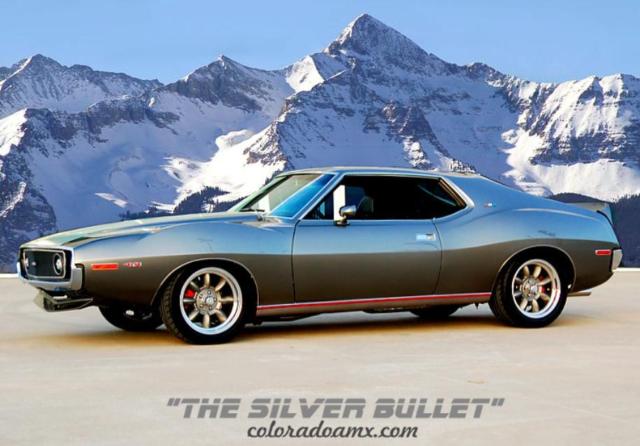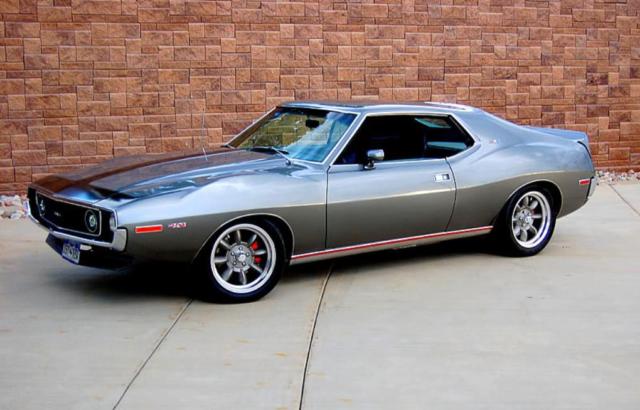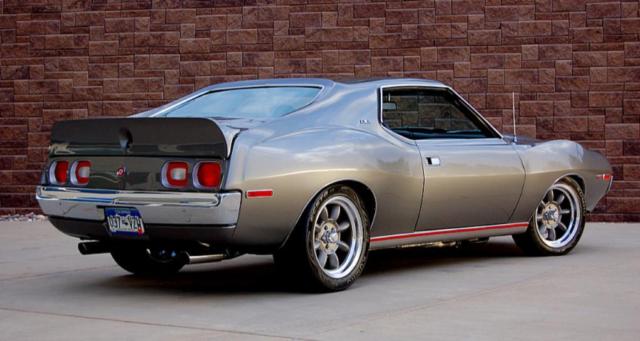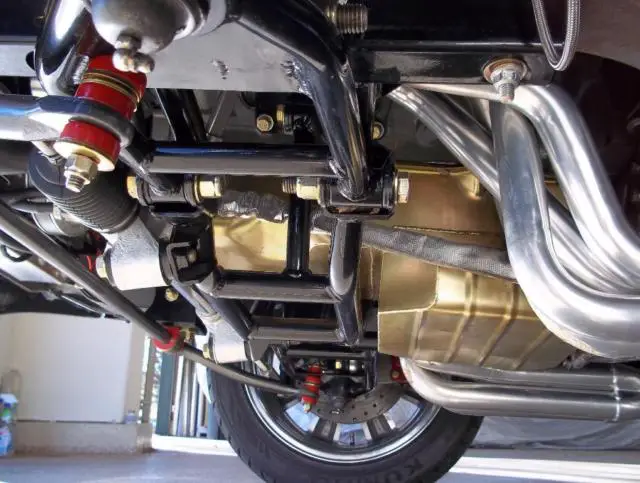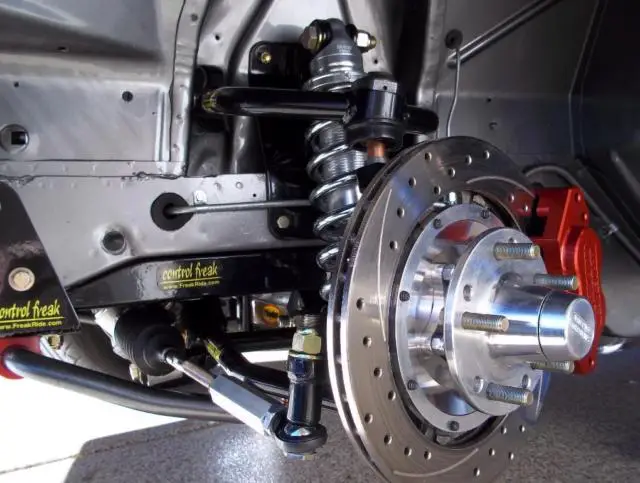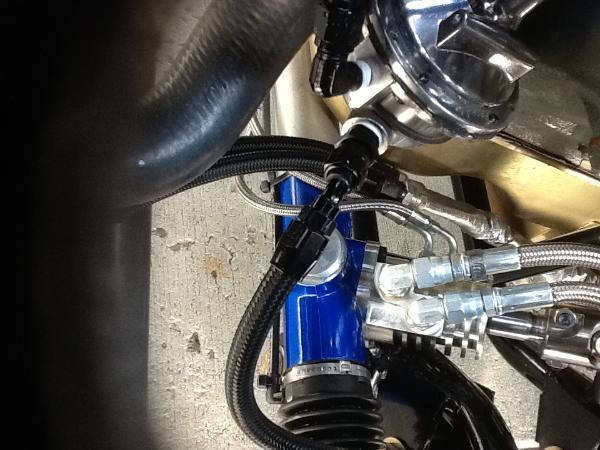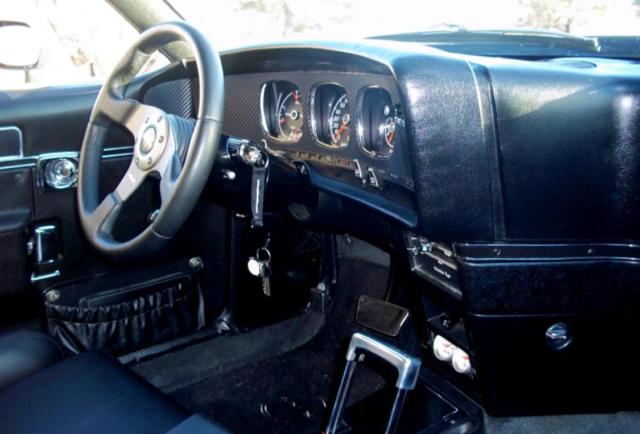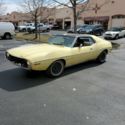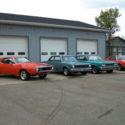Pro Touring Javelin
| Make: | AMC |
| Model: | Javelin |
| Year: | 1973 |
| Mileage: | 67,000 |
| Color: | Greystone Metalic |
| Engine: | 401 |
| Cylinders: | 8 |
| Fuel: | Gasoline |
| Transmission: | 727 |
| Drive type: | RWD |
| Interior color: | Black |
| Vehicle Title: | Clear |
| Item location: | Parker, Colorado, United States |
1973 AMC Javelin Additional Info:
The "Silver Bullet"This is the Pro-Touring Javelin featured in the March, 2012 issue of Hemmings Muscle Machines.
Below is the entire article:
Feature Article from Hemmings Muscle Machines
March, 2012 -Mike Bumbeck
Gracing a muscle car with a road-race stance is a well-known path to visual success. Ever taken a good look at a second-gen 1971-'74 AMC Javelin with the base pizza-cutter wheel- and-tire combo and full wheel covers? Great, in its own way. The same 1971-'74 Javelin in Penske-Donohue Trans-Am specification, hugging the ground, brimming with spoilers, with as much rubber as possible stuffed under a flared-out body, painted in red, white and blue Trans-Am livery? A Javelin orders-of-magnitude more wicked.The coke-bottle shape and long-nosed design of the Javelin are polarizing. A well-sorted Javelin can cause jaws to either drop or start moving very fast, with not much of anything we could reprint here for various reasons. The key is that Trans-Am racing influenced the second-generation design. The wheel humps on the long hood were not just there for looks. The aerodynamic spoilers that made the Javelin AMX package the hot setup were born of the race track. That the Javelin AMX looked like a race car was no accident.Penske and driver Mark Donohue entered the AMC arena with the 1970 racing season. SCCA rule changes had loosened enough to allow for modified engine internals as long as the displacement remained limited to 305 cubic inches. Suspension pivot points, brakes, and rear differentials could drift from factory stock pieces. Early problems with oil control and resulting sidelined AMC engines prevented the cars from cleaning up in the 1970 racing season, but that would soon change.The oiling problems were history for 1971, with a change in the SCCA rules that allowed for dry sump systems. Suddenly, it was the AMC Javelin that had the edge over a field of Mustangs and Camaros. The second and, sadly, last generation AMC Javelin AMX is a case of racing-inspired design in homologated form. Donohue had driver and racer input on everything from chin spoiler and flush grille to the rear spoiler and overall body design. Anyone who's driven any stock muscle car into the triple digits can attest to the utility of a chin spoiler, or at the very least a flush-mount grille.Just ask Wayne Davis, whose dad was a Studebaker man, uncle a Rambler guy, and cousin in possession of a brand-new 1969 AMX right out of high school. A combination of rivalry and awe at his cousin's high school graduation present set the AMC mark in 1969. While Frank Sinatra may croon about a few regrets, Wayne could say with no regret that he had a few Javelins; so many, in fact, that he can only produce a rough reconstruction of the actual number."My first AMX was a 1972 Javelin AMX with a 360 automatic. I can't really count them... probably eight or nine two-seater AMXs. Several Javelins. A '68 AMC Rebel. This car is my second Javelin AMX; of course, it didn't start out as a Javelin AMX. It was pretty much a base Javelin."Wayne enjoys his AMC obsession and hobby with his son, and the acquisition of this Javelin that would become an AMX was planned as a father/son team operation from the outset. The pair had already built a few two-seater AMX cars and a few Javelins--but this project was planned as a concept. Wayne had the Trans-Am-winning Javelins in mind when he conceived what he refers to as "the gray car.""I made the mistake one day of saying to my son, 'If I could find a Javelin AMX,' which is what I call a second-generation Javelin, 'it would be kind of nice to build one with what I call the right stance,'" Wayne said.The 1973 Javelin that started the project was about 10 miles from Wayne's Elizabeth, Colorado, home, and by Wayne's own account, was a used-up driver at best. The car was a bright shade of banana yellow when Wayne and his son got hold of it, but came out of the factory in what could be referred to as deep Matador brown. Earth tones were a popular Seventies selection for both exterior and interior colors. "I'm not sure what the exact name of the color was. It was not attractive, even though I'm sure it was in 1973," said Wayne.The Oregon-sourced Javelin had a solid body, with the exception of the rear quarter panels, which Wayne figures rusted out as a result of a leaky rear window. Patch panels were the solution. The deal Wayne made with the previous owner was for a roller, so the wheels and engine were returned once the Javelin got back to the shop and the project began in October of 2009. The car was finished by July of 2010."I say finished, but finished is a relative term. Once the Control Freak suspension became available, I put that in it. I had originally put the stock suspension in the front, with a coil-over setup that worked with the stock upper control arms. I've since pulled all that out and put the Control Freak in it."The Control Freak Wayne is referring to is a company producing an independent front suspension (IFS) with manual rack-and-pinion steering specifically for AMC cars. Once the suspension was installed, the Javelin went on Wayne's hauler down to a local alignment shop to get dialed in for handling. Everything had changed, in this case for the better.Along with the usual alignment, the Javelin now boasts six degrees of negative caster, which Wayne says is an improvement over the essentially non-adjustable factory caster. The original AMC single-mount lower control arms and locating struts are replaced by lower A-arms in what is also known as a double-wishbone setup. The rear suspension features QA1 dampers working with Eaton Detroit leaf springs, which are stiffer than stock and arched for a one-and-a-half-inch drop over the stock height.Wayne mimicked the look of the Trans-Am Minilite-style wheels with a set of Team 3 LT III wheels. The set was ordered staggered with custom backspacing to specification. The four-wheel disc brakes came from Aerospace Components for a larger-than-stock 13-inch big-brake configuration. The disc swap was a bolt-in replacement, complete with any mounts to replace rear drum backing plates and all the parts and pieces to finish the job.Wayne took a 401 engine he had in his garage and went mildly over stock specifications with a full rebuild. Edelbrock aluminum heads were shod with sheetmetal valve covers from Unique Aluminum Products. A new Milodon road-racing pan feeds the timing-cover-mounted oil pump, which itself was improved by Bulltear. A 2,000-RPM stall converter spins in place of the stock unit. With the exception of a shift kit, the automatic transmission is built to the same specification as the 1973 AMC Torque-Command, which is more or less a Chrysler 727 TorqueFlite.Although the Control Freak IFS replaces the entire front suspension, it uses factory mounting points, and Wayne said it bolted into the unit-body with a minimum of surprises. However, because it was designed around a stock Javelin, the Milodon road-racing pan on the 401 led to a few issues. The oil filter adapter drops the filter location a few inches from stock, which presented fitment challenges. A smaller filter was used in place temporarily, replaced by a remote mount filter that solved that clearance issue.A similar obstacle was produced by the Edelbrock aluminum cylinder heads. The headers that fit perfectly on the stock heads ran into the heads along the lower edge of the flange and led to clearance problems. These are the pitfalls inherent in modifying factory engineering, none of which were insurmountable."One thing leads to something else, and you have all sorts of little things like that," said Wayne.The biggest series of challenges came with taking a standard Javelin and transforming it into an AMX version using as many original pieces as possible. While some parts can be found in reproduction form, others have to be found as used factory. That includes interior bits and external badges particular to the Javelin AMX. The door panels are unique to the AMX. The factory turned-metal dash is not being reproduced, and none of the dashes Wayne sourced had survived. Time was not kind to original AMX parts, and low production numbers also present challenges."I think I bought four or five dashes before I found one that was good enough to put in the car. I had to rebuild the back of the one I had to put in the car. These things are all 40-something-years-old now. They didn't make a lot of Javelin AMXs. Trying to find stuff that's in decent shape is tough. It's out there, but you're going to pay," said Wayne.Wayne's Javelin was built for GT-style driving. He currently drives his orange 1970 AMX more than the '73, once motoring out to the Pueblo Motorsports Park for a Trans-Am invitational event. Wayne has driven a few race tracks through the Panoz Racing School, and while he has no intention of racing this or any of his current collection of AMC cars, he would like to test the finished product on the curves and straights of a road course unencumbered by speed limits and opposing traffic."The Control Freak suspension is something I want to really test out, and I want to see how that Milodon road-race pan works. That's a brand-new design pan; it has five trap doors in it. I'm interested to see how the gear ratio is going to work in that car, too. I think it's set up well for a road course," said Wayne.As Wayne mentioned before, "finished" is a relative term. He's waiting on development of a power steering rack for the IFS, pondering a six-speed manual transmission and thinking of wider wheel and tire packages, along with some more interior upgrades. This sort of hobby can be addictive, and this 1973 Javelin is on a discretionary trajectory.OWNER'S VIEW
I wanted that same look as the Trans-Am Javelins, perhaps even a little more aggressive. That's exactly where the inspiration came from. Most other cars I started out wanting to make look original and so on, but this car I wanted this particular look.The car is different from stock in a couple of ways. I went from power steering to a manual rack, which means parking lots are a challenge with the wider rubber up front, but once you're moving it's not an issue. Handling is much more sophisticated. There's much more isolation from the springs over the stock suspension. With the stock suspension, any bumps or anything would jar the unit-body, so you would feel that in the car. It has a one-inch anti-roll bar in the front, and a three-quarter-inch anti-roll bar in the back. Those made a huge difference as well. This thing is awesome--just glued to the road. You just point it and go.
-- Wayne Davis
The car has won multiple show awards including the Goodguys "American Thunder"Award in DesMoines. This is perhaps the mostcopied pro-touring Javelin since it was featured in Hemmings.
BODY and Drivetrain:
The body was completely media blasted then sent to
Painted Dreams in Elizabeth, CO (the body and Paint exceeded $20,000)
GM color; GreystoneMetallic
Corbeau Leather Racing Seats/Harnesses
Control FreakIndépendantFront Suspension w/Afcocoil-overs
Flaming RiverPowerRack &Pinion steering (In some of thephotos, a manual rack is pictured)
March power steering pump w/ modified valving
Flaming River Tilt SteeringColumn
All suspension parts powder coated
Road race aluminum body rear shocks
Rear bar pak
Complete new reprowiring harnesses
newly chromed front and rearbumpers
17" miniliteTeam III LT-IIIwheels
rear tiresKumho285/40/17
frontTires Kumho245/45/17
Heddman long tube ceramic coated Headers
Brakes, 4 wheeldrilled and slotteddiscbyAerospaceComponents4piston calipers
NOS rear tailights
Aluminum radiatorw/ Dual Spal Fans
Moser solid axles
727 Trans w/ mods
11" torque converter w/ 2000 stall
Custom exhaust w/ Flowmaster 40s
ENGINE:
AMC 401
.0030 Weisco forgedpistons/plasmamoly ringsAMC forged rodsAMC forged crankshaft
Balanced rotating assembly
internal oiling mods
Edelbrock aluminum heads
Comp Cams Camkit/roller rockers
Milodonroad race oil pan w/ externallines
Edelbrock AirGap aluminum intake
Edelbrock Thunder series 750 cfmcarb
SFI certified harmonicbalancer/flexplate
Bulltear Serpentine pulleys 10%underdrive
Mallory Unilite Distrbutor
Sheet Metal Valve Covers
Engine color; Traco Grey
Promaster Starter and Alternator
Milodon Water PumpTransmission cooler
Bulltear Remote Filter adapter and DrySumpPick-up w/K&P Billet Oil Filter
I can answer any questions @ 303-642-5446. Seriousinquiries only.
